 полная версия
полная версияMy Studio Neighbors
Indeed, the presence of this intruded egg, like that of the European cuckoo in similar fragile nests, has given rise to the popular belief that the bird must resort to exceptional means in these instances. Sir William Jardine, for instance, in an editorial foot-note in one of Gilbert White's pages, remarks:
"It is a curious fact, and one, I believe, not hitherto noticed by naturalists, that the cuckoo deposits its egg in the nests of the titlark, robin, and wagtail by means of its foot. If the bird sat on the nest while the egg was laid, the weight of its body would crush the nest and cause it to be forsaken, and thus one of the ends of Providence would be defeated. I have found the eggs of the cuckoo in the nest of a white-throat, built in so small a hole in a garden wall that it was absolutely impossible for the cuckoo to have got into it."
In the absence of substantiation, this, at best, presumptive evidence is discounted by the well-attested fact that the cuckoo has frequently been shot in the act of carrying a cuckoo's egg in its mouth, and there is on record an authentic account of a cuckoo which was observed through a telescope to lay her egg on a bank, and then take it in her bill and deposit it in the nest of a wagtail.
There is no evidence to warrant a similar resource in our cow-bird, though the inference would often appear irresistible, did we not know that Wilson actually saw the cow-bird in the act of laying in the diminutive nest of a red-eyed vireo, and also in that of the bluebird.
And what is the almost certain doom of the bird-home thus contaminated by the cow-bird?
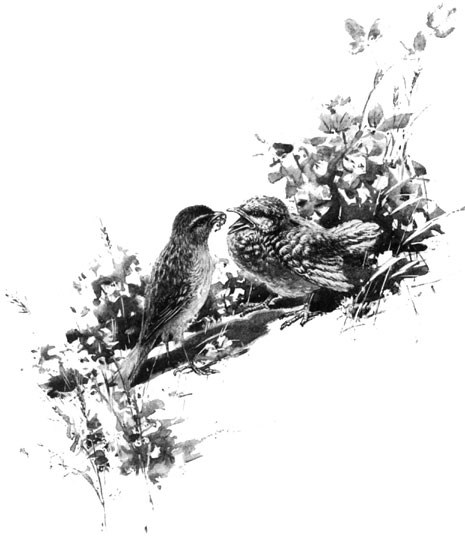
A Greedy Foster-child
The egg is always laid betimes, and is usually the first to hatch, the period of incubation being a day or two less than that of the eggs of the foster-parent. And woe be to the fledglings whom fate has associated with a young cow-bird! He is the "early bird that gets the worm." His is the clamoring red mouth which takes the provender of the entire family. It is all "grist into his mill," and everything he eats seems to go to appetite—his bedfellows, if not thus starved to death, being at length crushed by his comparatively ponderous bulk, or ejected from the nest to die. It is a pretty well established fact that the cuckoo of Europe deliberately ousts its companion fledglings—a fact first noted by the famous Dr. Jenner. And Darwin has even asserted that the process of anatomical evolution has especially equipped the young cuckoo for such an accomplishment—a practice in which some accommodating philosophic minds detect the act of "divine beneficence," in that "the young cuckoo is thus insured sufficient food, and that its foster-brothers thus perish before they have acquired much feeling."
The following account, written by an eye-witness, bears the stamp of authenticity, and is furthermore re-enforced by a careful and most graphic drawing made on the spot, which I here reproduce, and fully substantiates the previous statement by Dr. Jenner. The scene of the tragedy was the nest of a pipit, or titlark, on the ground beneath a heather-bush. When first discovered it contained two pipit's eggs and the egg of a cuckoo.
"At the next visit, after an interval of forty-eight hours," writes Mrs. Blackburn, "we found the young cuckoo alone in the nest, and both the young pipits lying down the bank, about ten inches from the margin of the nest, but quite lively after being warmed in the hand. They were replaced in the nest beside the cuckoo, which struggled about till it got its back under one of them, when it climbed backward directly up the open side of the nest and pitched the pipit from its back on to the edge. It then stood quite upright on its legs, which were straddled wide apart, with the claws firmly fixed half-way down the inside of the nest, and, stretching its wings apart and backward, it elbowed the pipit fairly over the margin so far that its struggles took it down the bank instead of back into the nest. After this the cuckoo stood a minute or two feeling back with its wings, as if to make sure that the pipit was fairly overboard, and then subsided into the bottom of the nest.
"I replaced the ejected one and went home. On returning the next day, both nestlings were found dead and cold out of the nest.... But what struck me most was this: the cuckoo was perfectly naked, without a vestige of a feather, or even a hint of future feathers; its eyes were not yet opened, and its neck seemed too weak to support the weight of the head. The pipit had well-developed quills on the wings and back, and had bright eyes, partially open, yet they seemed quite helpless under the manipulations of the cuckoo, which looked a much less developed creature. The cuckoo's legs, however, seemed very muscular; and it appeared to feel about with its wings, which were absolutely featherless, as with hands, the spurious wing (unusually large in proportion) looking like a spread-out thumb."
Considering how rarely we see the cow-bird in our walks, her merciless ubiquity is astonishing. It occasionally happens that almost every nest I meet in a day's walk will show the ominous speckled egg. In a single stroll in the country I have removed eight of these foreboding tokens of misery. Only last summer I discovered the nest of a wood-sparrow in a hazel-bush, my attention being attracted thither by the parent bird bearing food in her beak. I found the nest occupied, appropriated, monopolized, by a cow-bird fledgling—a great, fat, clamoring lubber, completely filling the cavity of the nest, the one diminutive, puny remnant of the sparrow's offspring being jammed against the side of the nest, and a skeleton of a previous victim hanging among the branches below, with doubtless others lost in the grass somewhere in the near neighborhood, where they had been removed by the bereaved mother. The ravenous young parasite, though not half grown, was yet bigger by nearly double than the foster-mother. What a monster this! The "Black Douglass" of the bird home; a blot on Nature's page!
As in previous instances, observing that the interloper had a voice fully capable of making his wants known, I gave the comfortable little beast ample room to spread himself on the ground, and let the lone little starveling survivor of the rightful brood have his cot all to himself.
And yet, as I left the spot, I confess to a certain misgiving, as the pleading chirrup of the ousted fledgling followed me faintly and more faintly up the hill, recalling, too, the many previous similar acts of mine—and one in particular, when I had slaughtered in cold blood two of these irresponsibles found in a single nest. But sober second thought evoked a more philosophic and conscientious mood, the outcome of which leading, as always, to a semi-conviction that the complex question of reconciliation of duty and humanity in the premises was not thus easily disposed of, considering, as I was bound to do, the equal innocence of the chicks, both of which had been placed in the nest in obedience to a natural law, which in the case of the cow-bird was none the less a divine institution because I failed to understand it. Such is the inevitable, somewhat penitent conclusion which I always arrive at on the cow-bird question; and yet my next cow-bird fledgling will doubtless follow the fate of all its predecessors, the reminiscent qualms of conscience finding a ready philosophy equal to the emergency; for if, indeed, this parasite of the bird home be a factor in the divine plan of Nature's equilibrium, looking towards the survival of the fittest and the regulation of the sparrow and small-bird population, which we must admit, how am I to know but that this righteous impulse of the human animal is not equally a divine, as it is certainly a natural institution looking to the limitations of the cow-bird? One June morning, a year or two ago, I heard a loud squeaking, as of a young bird in the grass near my door, and, on approaching, discovered the spectacle of a cow-bird, almost full-fledged, being fed by its foster-mother, a chippy not more than half its size, and which was obliged to stand on tiptoe to cram the gullet of the parasite.
The victims of the cow-bird are usually, as in this instance, birds of much smaller size, the fly-catchers, the sparrows, warblers, and vireos, though she occasionally imposes on larger species, such as the orioles and the thrushes. The following are among its most frequent dupes, given somewhat in the order of the bird's apparent choice: song-sparrow, field-sparrow, yellow warbler, chipping-sparrow, other sparrows, Maryland yellow-throat, yellow-breasted chat, vireos, worm-eating warbler, indigo-bird, least-flycatcher, bluebird, Acadian flycatcher, Canada flycatcher, oven-bird, king-bird, cat-bird, phœbe, Wilson's thrush, chewink, and wood-thrush.
But one egg is usually deposited in a single nest; the presence of two eggs probably indicates, as in the case of the European cuckoo, the visits of two cow-birds rather than a second visit from the same individual—the presence of two cow-bird chicks of equal size being rather a proof of this than otherwise, in that kind Nature would seem to have accommodated the bird with an exceptional physiological resource, which matures its eggs at intervals of three or more days, as against the daily oviposition of its dupes, thus giving it plenty of time to make its search and take its pick among the bird-homes. Whether the process of evolution has similarly equipped our cow-bird I am not aware; but the vicious habits of the two birds are so identical that the same accommodating functional conditions might reasonably be expected. It is, indeed, an interesting fact well known to ornithologists that our own American cuckoos, both the yellow-billed and black-billed, although rudimentary nest-builders, still retain the same exceptional interval in their egg-laying as do their foreign namesake. The eggs are laid from four days to a week apart, instead of daily, as with most birds, their period of perilous nidification on that haphazard apology of a nest being thus possibly prolonged to six weeks. Thus we find, in consequence, the anomalous spectacle of the egg and full-grown chick, and perhaps one or two fledglings of intermediate stages of growth, scattered about at once, helter-skelter, in the same nest. Only two years ago I discovered such a nest not a hundred feet from my house, containing one chick about two days old, another almost full-fledged, while a fresh-broken egg lay upon the ground beneath. Such a household condition would seem rather demoralizing to the cares of incubation, and doubtless the addled or ousted egg is a frequent episode in our cuckoo's experience.
It is an interesting question which the contrast of the American and European cuckoo thus presents. Is the American species a degenerate or a progressive nest-builder? Has she advanced in process of evolution from a parasitical progenitor building no nest, or is the bird gradually retrograding to the evil ways of her notorious namesake?
The evidence of this generic physiological peculiarity in the intervals of oviposition, taken in consideration with the fact of the rudimentary nest, would seem to indicate the retention of a now useless physiological function, and that the bird is thus a reformer who has repudiated the example of her ancestors, and has henceforth determined to look after her own babes.
With the original presumed object of this remarkable prolonged interval in egg-laying now removed, the period will doubtless be reduced through gradual evolution to accommodate itself to the newly adopted conditions. The week's interval, taken in connection with the makeshift nest or platform of sticks, is now a disastrous element in the life of the bird. Such of the cuckoos, therefore, as build the more perfect nests, or lay at shortest intervals, will have a distinct advantage over their less provident fellows, and the law of heredity will thus insure the continual survival of the fittest.
The cuckoo is not alone among British birds in its intrusion on other nests. Many other species are occasionally addicted to the same practice, though such acts are apparently accidental rather than deliberate, so far as parasitical intent is concerned. The lapse is especially noticeable among such birds as build in hollow trees and boxes, as the woodpeckers and wagtails. Thus the English starling will occasionally impose upon and dispossess the green woodpecker. In the process of nature in such cases the stronger of the two birds would retain the nest, and thus assume the duties of foster-parent. Starting from this reasonable premise concerning the prehistoric cuckoo, it is not difficult to see how natural selection, working through ages of evolution by heredity, might have developed the habitual resignation of the evicted bird, perhaps to the ultimate entire abandonment of the function of incubation. Inasmuch as "we have no experience in the creation of worlds," we can only presume.
Indeed, the similarities and contrasts afforded by a comparison of the habits of all these birds—European cuckoo, American cuckoo, and cow-bird—afford an interesting theme for the student of evolution. What is to be the ultimate outcome of it all? for the murderous cuckoo must be considered merely as an innocent factor in the great scheme of Nature's equilibrium, in which the devourer and the parasite would seem to play the all-important parts, the present example being especially emphasized because of its conspicuousness and its violence to purely human sentiment. The parasite would often seem to hold the balance of power.
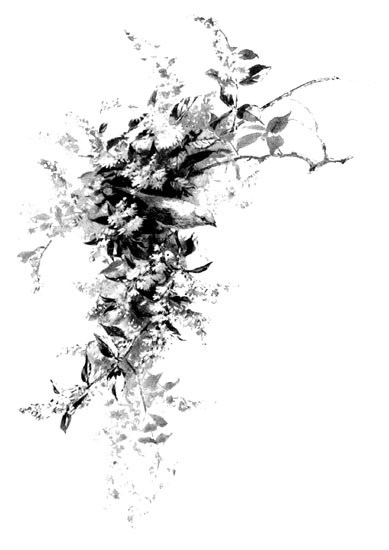
The Yellow Warbler
Jonathan Swift's epitome of the subject, if not specifically true, is at least correct in its general application:
"A fleaHas smaller fleas that on him prey;And these have smaller still to bite 'em;And so proceed ad infinitum."Even the tiny egg of a butterfly has its ichneumon parasite, a microscopic wasp, which lays its own egg within the larger one, which ultimately hatches a wasp instead of the baby caterpillar.
But who ever heard of anything but good luck falling to the lot of cow-bird or cuckoo, except as its blighting course is occasionally arrested by the outraged human? They always find a feathered nest.
In this connection it is interesting to note certain developments in bird life upon the lines of which evolution might work with revolutionary effect. Most of our birds are helpless and generally resigned victims to the cow-bird, but there are indications of occasional effective protest among them. Thus the little Maryland yellow-throat, according to various authorities, often ousts the intruded egg, and its broken remains are also occasionally seen on the ground beneath the nests of the cat-bird and the oriole. The red-eyed vireo, on the other hand, though having apparently an easier task than the latter, in the lesser depth of her pensile nest, commonly abandons it altogether to the unwelcome speckled ovum—always, I believe, if the cow-bird has anticipated her own first egg.
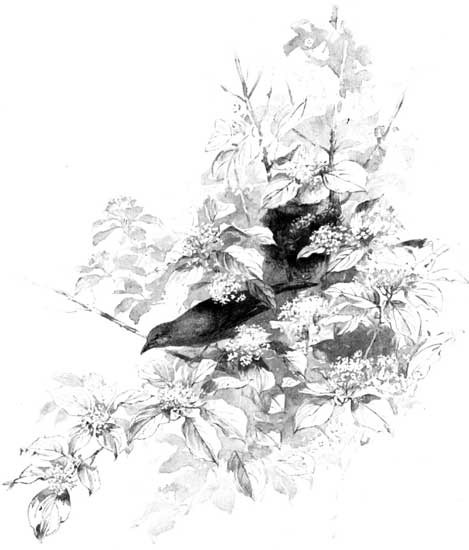
A Blighted Home
But we have a more remarkable example of opposition in the resource of the little yellow warbler, which I have noted as one of the favorite dupes of the cow-bird—a deliberate, intelligent, courageous defiance and frequent victory which are unique in bird history, and which, if through evolutionary process they became the fashion in featherdom, would put the cow-bird's mischief greatly at a discount. The identity of this pretty little warbler is certainly familiar to most observant country dwellers, even if unknown by name, though its golden-yellow plumage faintly streaked with dusky brown upon the breast would naturally suggest its popular title of "summer yellow-bird." It is one of the commonest of the mnio-tiltidæ, or wood-warblers, though more properly a bird of the copse and shrubbery than of the woods.
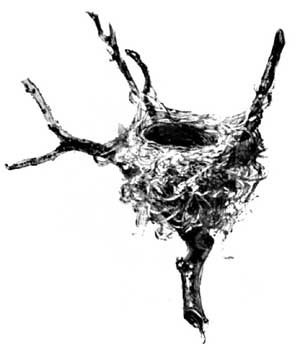
The Normal Nest of the Yellow Warbler
This nest is a beautiful piece of bird architecture. In a walk in search of one only a day or two ago I procured one, which is now before me. It was built in the fork of an elder-bush, to which it was moored by strips of fine bark and cobweb, its downy bulk being composed by a fitted mass of fine grass, willow cotton, fern wood, and other similar ingredients. It is about three inches in depth, outside measurement. But this depth greatly varies in different specimens. Our next specimen may afford quite a contrast, for the yellow warbler occasionally finds it to her interest to extend the elevation of her dwelling to a remarkable height. On page 50 is shown one of these nests, snugly moored in the fork of a scrub apple-tree. Its depth from the rim to the base, viewed from the outside, is about five inches, at least two inches longer than necessity would seem to require, and apparently with a great waste of material in the lower portion, as the hollow with the pretty spotted eggs is of only the ordinary depth of about two inches, thus hardly reaching half-way to the base. Let us examine it closely. There certainly is a suspicious line or division across its upper portion, about an inch below the rim, and extending more or less distinctly completely around the nest. By a very little persuasion with our finger-tip the division readily yields, and we discover the summit of the nest to be a mere rim—a top story, as it were—with a full-sized nest beneath it as a foundation. Has our warbler, then, come back to his last year's home and fitted it up anew for this summer's brood? Such would be a natural supposition, did we not see that the foundation is as fresh in material as the summit. Perhaps, then, the bird has already raised her first spring brood, and has simply extended her May domicile, and provided a new nursery for a second family. But either supposition is quickly dispelled as we further examine the nest; for in separating the upper compartment we have just caught a glimpse of what was, perhaps only yesterday, the hollow of a perfect nest; and, what is more to the point of my story, the hollow contains an egg—perhaps two, in which case they will be very dissimilar, one of delicate white with faint spots of brown on its larger end, the putting of the warbler, the other much larger, with its greenish surface entirely speckled with brown, and which, if we have had any experience in bird-nesting, we immediately recognize as the mischievous token of the cow-bird. We have discovered a most interesting curiosity for our natural-history cabinet—the embodiment of a presumably new form of intelligence in the divine plan looking to the survival of the fittest. It is not known how many years or centuries it has taken the little warbler to develop this clever resource to outwit the cow-bird. It is certain, however, that the little mother has got tired of being thus imposed upon, and is the first of her kind on record which has taken these peculiar measures for rising above her besetting trouble.

The Yellow Warbler at Home
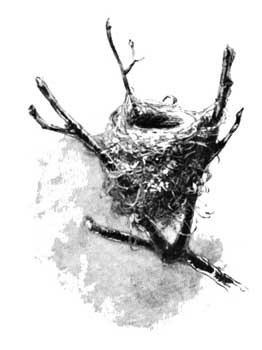
A Suspicious Nest of the Yellow Warbler
Who can tell what the future may develop in the nests of other birds whose homes are similarly invaded? I doubt not that this crying cow-bird and cuckoo evil comes up as a matter of consideration in bird councils. The two-storied nest may yet become the fashion in featherdom, in which case the cow-bird and European cuckoo would be forced to build nests of their own or perish.
But have we fully examined this nest of our yellow warbler? Even now the lower section seems more bulky than the normal nest should be. Can we not trace still another faint outline of a transverse division in the fabric, about an inch below the one already separated? Yes; it parts easily with a little disentangling of the fibres, and another spotted egg is seen within. A three-storied nest! A nest full of stories—certainly. I recently read of a specimen containing four stories, upon the top of which downy pile the little warbler sat like Patience on a monument, presumably smiling at the discomfiture of the outwitted cow-bird parasite, who had thus exhausted her powers of mischief for the season, and doubtless convinced herself of the folly of "putting all her eggs in one basket."
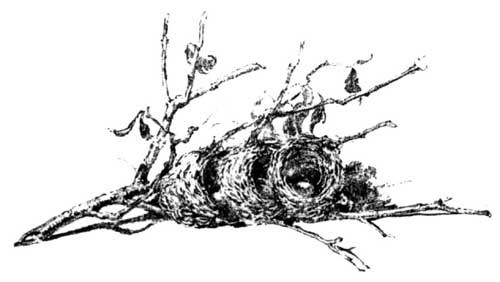
The Nest Separated
When we consider the life of the cow-bird, how suggestive is this spectacle which we may see every year in September in the chuckling flocks massing for their migration, occasionally fairly blackening the trees as with a mildew, each one the visible witness of a double or quadruple cold-blooded murder, each the grim substitute for a whole annihilated singing family of song-sparrow, warbler, or thrush! What a blessing, at least humanly speaking, could the epicurean population en route in the annual Southern passage of this dark throng only learn what a surpassing substitute they would prove—on toast—for the bobolinks which as "reed-birds" are sacrificed by the thousands to the delectable satisfaction of those "fine-mouthed and daintie wantons who set such store by their tooth"!
And what the cow-bird is, so is the Continental "cuckoo." Shall we not discriminate in our employment of the superlative? What of the throstle and the lark? Shall we still sing—all together:
"O cuckoo! I hear thee and rejoice!Thrice welcome darling of the spring."DOOR-STEP NEIGHBOURS
HOW little do we appreciate our opportunities for natural observation! Even under the most apparently discouraging and commonplace environment, what a neglected harvest! A back-yard city grass-plot, forsooth, what an invitation! Yet there is one interrogation to which the local naturalist is continually called to respond. If perchance he dwells in Connecticut, how repeatedly is he asked, "Don't you find your particular locality in Connecticut a specially rich field for natural observation?" The botanist of New Jersey or the ornithologist of Esopus-on-Hudson is expected to give an affirmative reply to similar questions concerning his chosen hunting-grounds, if, indeed, he does not avail himself of that happy aphorism with which Gilbert White was wont to instruct his questioners concerning the natural-history harvest of his beloved Selborne: "That locality is always richest which is most observed."
The arena of the events which I am about to describe and picture comprised a spot of almost bare earth less than one yard square, which lay at the base of the stone step to my studio door in the country.
The path leading to the studio lay through a tangle of tall grass and weeds, with occasional worn patches showing the bare earth. As it approached the door-step the surface of the ground was quite clean and baked in the sun, and barely supported a few scattered, struggling survivors of the sheep's-sorrel, silvery cinquefoil, ragweed, various grasses, and tiny rushes which rimmed the border. Sitting upon this threshold stone one morning in early summer, I permitted my eyes to scan the tiny patch of bare ground at my feet, and what I observed during a very few moments suggested the present article as a good piece of missionary work in the cause of nature, and a suggestive tribute to the glory of the commonplace. The episodes which I shall describe represent the chronicle of a single day—in truth, of but a few hours in that day—though the same events were seen in frequent repetition at intervals for months. Perhaps the most conspicuous objects—if, indeed, a hole can be considered an "object"—were those two ever-present features of every trodden path and bare spot of earth anywhere, ant-tunnels and that other circular burrow, about the size of a quill, usually associated, and which is also commonly attributed to the ants.
As I sat upon my stone step that morning, I counted seven of these smooth clean holes within close range, three of them hardly more than an inch apart. They penetrated beyond the vision, and were evidently very deep. Knowing from past experience the wary tenant which dwelt within them, I adjusted myself to a comfortable attitude, and remaining perfectly motionless, awaited developments. After a lapse of possibly five minutes, I suddenly discovered that I could count but five holes; and while recounting to make sure, moving my eyes as slowly as possible, my numeration was cut short at four. In another moment two more had disappeared, and the remaining two immediately followed in obscurity, until no vestige of a hole of any kind was to be seen. The ground appeared absolutely level and unbroken. Were it not for the circular depression, or "door-yard," around each hole, their location would, indeed, have been almost impossible. A slight motion of one of my feet at this juncture, however, and, presto! what a change! Seven black holes in an instant! And now another wait of five minutes, followed by the same hocus-pocus, and the black spots, one by one, vanishing from sight even as I looked upon them. But let us keep perfectly quiet this time and examine the suspected spots more carefully. Locating the position of the hole by the little circular "door-yard," we can now certainly distinguish a new feature, not before noted, at the centre of each—two sharp curved prongs, rising an eighth of an inch or more above the surface and widely extended.




